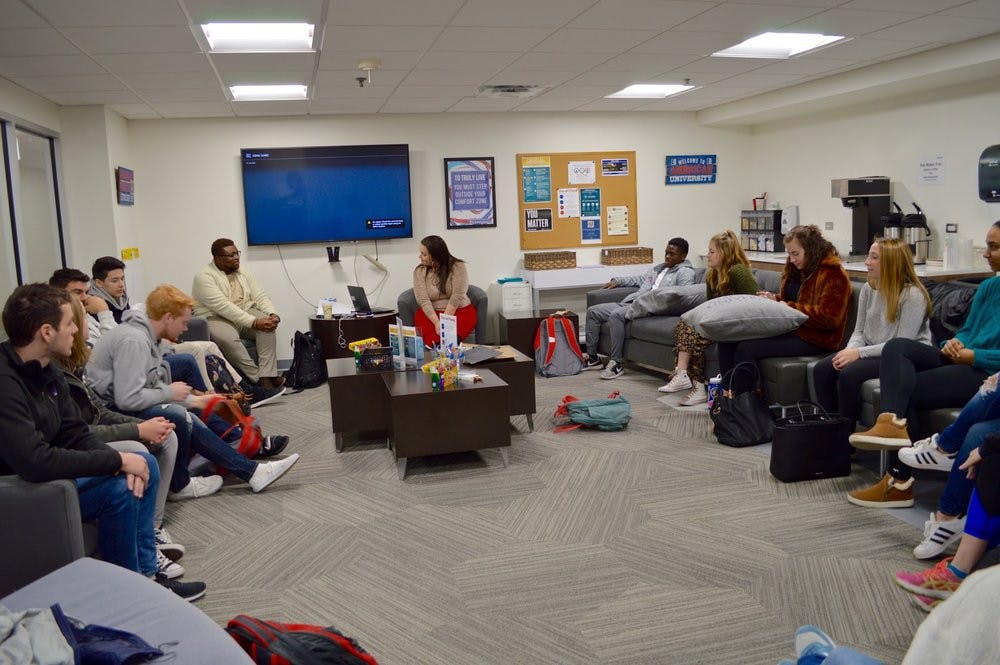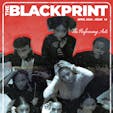BY: ALEXIS ARNOLD

Photo provided by AUx
Professor Andrea Brenner, Ph.D., is the director and curriculum designer of the program that is changing the focus of the first-year experience at AU: American University Experience (AUx). Starting fall 2018, all first-year students will be required to take the three-credit course as part of the new AU core curriculum.
The 95 sections of AUx will be held in three non-traditional spaces around campus. The Anderson-Centennial classroom was created just for this program - complete with couches, a media screen and coffee bar. Brenner stressed the importance of having comfortable spaces to help students be more open to difficult discussions.
AUx is split between two semesters. In the fall, students take a one-and-a-half credit class, called AUx1, that helps them transition into college life. In this half of the course, Brenner says students cover topics like their Title IX rights, budgeting and time management skills, and drug and alcohol education. Come spring, they're ready to tackle more complicated issues, like race, identity and privilege, in another one-and-a-half credit class called AUx2.

Anderson-Centennial AUx classroom. Photo provided by AUx.
AUx will be integrated as the university moves towards a first-year advising system. Each freshman will be assigned an advisor, independent of their academic school, who will double as AUx instructors. Classes are co-facilitated by a peer leader with junior or senior standing.
AUx has been in pilot stages since 2015, and its official introduction into university curriculum comes after student demands for mandatory racial and cultural sensitivity training.
After collecting feedback from students, Brenner and her team have finally initiated a full rollout of the AUx program. We sat down with Professor Brenner to discuss the details:
Alexis Arnold: AUx is a little different since it's two one-and-a-half credit courses. What can incoming students expect in terms of the workload? How does that compare to the other classes that they will have?
Andrea Brenner: It is truly the workload of half of a three-credit class. We hold to the Carnegie [Unit], which is a standardized way to make sure that the reading and writing of any class is equitable for the credits that [students are] getting. [The class] meets once a week, and it is a hybrid course. That means all of the material is delivered to the student online through Blackboard. Then they have a follow-up discussion in class every week.
AA: What is unique about AUx?
AB: Well, the transitional aspect is pretty standard. Lots of colleges have that, so we didn't reinvent the wheel there. But what we do in AUx1 that is unique to AU is that we introduce some of the concepts that students will study in depth in AUx2. AUx1 is a [prerequisite] for AUx2, so we include some basic understandings of privilege, bias and discrimination. [Students learn the] difference between diversity and inclusion. We're getting students talking about some of the language, but [we're] being very aware that they are coming in with varied lived and academic experiences around these topics. But we want to get some standardized language, so [when] we move into AUx2, we'll be on the same page.

Prof. Andrea Brenner in her office
AA: So tell me about AUx2. Since it is intended to focus on race, identity, bias etc., what can students anticipate going into these conversations?
AB: AUx2 is a course that creates a platform for discussions, not only about race and social identity, but also gender, sexual expression, class, religion, disability and other identities. We use race as a jumping off point, and it's an important part of the course, but the course is not all about race. The course establishes what we like to call, 'common touchstones of knowledge,' of exploration and also of civil discourse and debate. So we talk about the roles of power. We talk about the roles of cultural discrimination. But we also weave in historical, sociological and current campus pieces. We are very transparent about things happening on our campus and in our country. AUx2 is a really lovely platform to be able to have those discussions.
AA: Are there any misconceptions about AUx?
AB: AUx2 does not set out to solve racial tensions on campus or in the world. It's not a band-aid, and it's not "Race 101." It is a discussion-based course we expect all students to learn from. It's not a course for white students, nor is it a course for students of color to be the educators. We try to avoid tokenization as much as possible. The idea here is really to learn from each other.
AA: There have been several racially-motivated and bias-related incidents on campus. How are those discussed in the classroom?

AUx2 course outline; materials range from academic journals to Youtube videos
AB: That is something that, as program director, I feel very strongly about. Sadly, we've had too many incidents on this campus, but it's not just on this campus. We're talking about policies that are happening in this country, as well. AUx2, specifically, is a platform where we pause discussion at any point and time and talk about what's happening. As soon as an incident takes place on campus, like the anti-immigration posters, faculty and student leaders will immediately get an email from me encouraging them to reach out their students. But every class will pause for some minutes and talk about it. We make sure students have a place to air concerns and ask questions.
AA: You are having some pretty deep discussions and will come across topics that may be contested. How do you deal with conflict in a classroom?
AB: Well, we have 16 hours of intensive training for the co-facilitators. And we spend a lot of that time talking about civil discourse in the classroom…Part of the reason it seems to be under control and, for the most part, well received is that these students have already created a community and have a class contract….I'm not saying there isn't dissent in the classroom. There certainly is, and it's welcome. But students often report they are comfortable disagreeing with the material in their AUx class.

Brenner and her team have made continuous updates to the curriculum and have expanded the program with each successful pilot.
Once the program finishes its full-scale run, there will be a better idea of whether or not AUx will produce the changes that many are hoping for.
If you would like to learn more about The AU Experience click here


